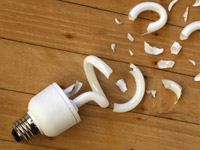How Dangerous Is a Broken Fluorescent Bulb?
Reports say mercury can be safely cleaned up
Q. After I bought a few compact fluorescent light (CFL) bulbs, I heard they contain mercury. How dangerous are these bulbs? What if one breaks?
A. Around the world, governments have passed measures to phase out incandescent light bulbs in favor of the more energy-efficient CFLs. It's true that CFL bulbs do contain a small amount of mercury, sealed within the glass tubing, and it can be released as vapor after a breakage.
See also: 18 ways to save on your utility costs.
Precautions are recommended, but how much actual risk is there?
An article in the August 2009 official magazine of the Illuminating Engineering Society of North America concluded that a worst-case scenario of mercury exposure (PDF) from a broken bulb is equivalent to eating one serving of fish. (Mercury accumulates in small amounts in the bodies of fish.)
Another article, in the European Commission's Scientific Committee on Health and Environmental Risks, concluded last year that significant health risks were unlikely for adults (PDF) when a broken CFL bulb was cleaned up properly. The committee said it didn't have enough data to assess the risk for children.
Similarly, an online fact sheet issued by the government of Australia says that proper cleanup presented no significant health risk to children or pregnant women.
Health officials advise certain precautions to minimize exposure. Among the steps recommended by the Environmental Protection Agency:
- Get people and pets out of the room.
- Air out the room for at least 10 minutes, and preferably several hours.
- Shut off the air-conditioning or heating system.
- Wipe up the broken glass and powder, seal them in a container and dispose of them.
- Check with your local government about disposal requirements. Some communities require that trashed fluorescent bulbs (broken or unbroken) be taken to a local recycling center.
Also of interest: Affordable Utilities Now! >>
Carole Fleck is a senior editor at the AARP Bulletin.

